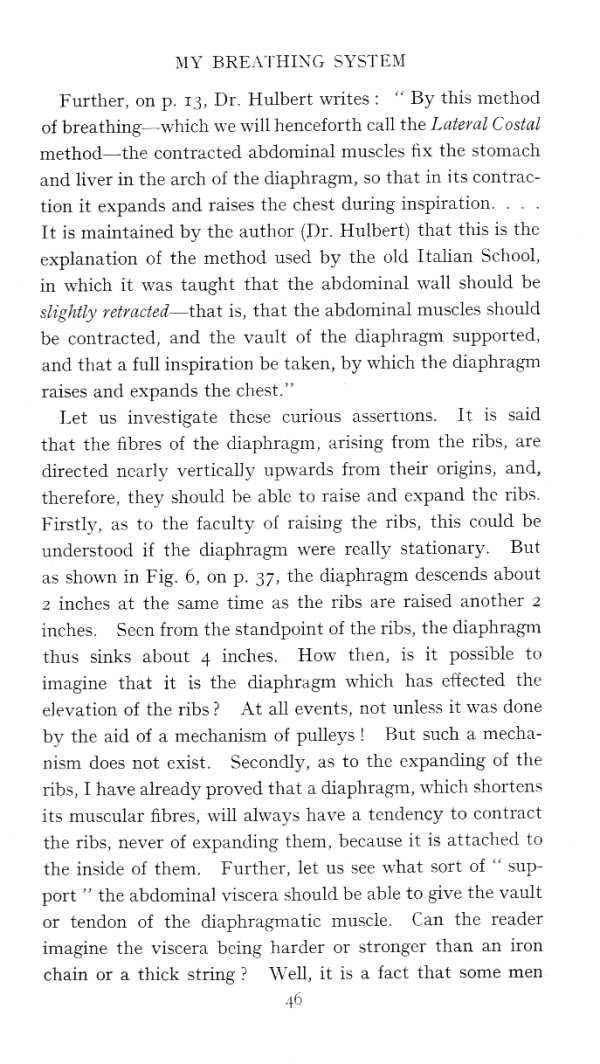mbs 046

MY BREATHING SYSTEM
Further, on p. 13, Dr. Hulbert \vrites : “ By this mcthod of breathing which we will heneeforth cali the Luteral Costal method—tlie contracted abdominal muscles fix the stornach and liver in the arch of the diaphragm, so that in its contrac-tion it expands and raises the chest during inspiration. . . . It is maintained by the author (Dr. Hulbert) that this is the explanation of the mcthod used by the okl Italian School, in which it was taught that the abdominal wali should be slightly retracted—that is, that the abdominal muscles should be contracted, and the vault of the diaphragm supported, and that a fuli inspiration be taken, by which the diaphragm raises and expands the chest.”
Let us investigate these curious assertions. It is said that the fibres of the diaphragm, arising from the ribs, are directed ncarly vertically upwards from their origins, and, therefore, they should be ablc to raise and cxpand the ribs. Firstly, as to the faculty of raising the ribs, this could be understood if the diaphragm were rcally stationary. But as shown in Fig. 6, on p. 37, the diaphragm descends about 2 inches at the same time as the ribs are raised another 2 inches. Scen from the standpoint of the ribs, the diaphragm thus sinks about 4 inches. How then, is it possible to imagine that it is the diaphragm which has cffected the elevation of the ribs ? At all events, not unless it was done by the aid of a mechanism of pulleys! But such a mecha-nism does not cxist. Secondly, as to the cxpanding of the ribs, I have already proved that a diaphragm, which shortens its muscular fibres, will always have a tcndency to contract the ribs, never of expanding them, because it is attached to the inside of them. Further, let us see what sort of “ sup-port ” the abdominal viseera should be able to give the vault or tendon of the diaphragmatic muscle. Can the reader imagine the viscera bcing harder or stronger than an iron chain or a thick string ? Weil, it is a fact that some men
46
Wyszukiwarka
Podobne podstrony:
60698 mbs 083 MY HREATHING SYSTEM compensation as possible should be afforded him by teaching him to
mbs 053 MY BREATHING SYSTEM navel, or at all events not higher than on a level with the openings of
mbs 005 MY BREATHING SYSTEM BYLIEUT. J. P. MI LLER, K.D. Author of My System," " My System
mbs 011 MY BREATHING SYSTEM and violent palpitatiops. Sncli an overstrained licart could never last
mbs 014 MY BREATHING SYSTEM slow, regular respiration, even during the hardcst and most protracted e
mbs 022 MY BREATHING SYSTEM against the invasion and throw ol f thc gernis, which arc ejected with t
mbs 027 MY BREATHING SYSTEM sucked in. For persons who lind it very difficult to acquire tłiis contr
mbs 035 MY BREATHING SYSTEM How to Expand and Contract the Thorax to its fullest Extent The thoracic
mbs 038 MY BREATHING SYSTEM scientiiically established this fact. He said, in a recent lecture : &qu
mbs 040 MY BREATHING SYSTEM expansiou alone gives tlić best result, others, Jikt* the French lieuteu
mbs 042 MY BREATHING SYSTEM the liarm done by such old habits that special excrcise of “ abdominal&q
mbs 047 MY BREATHING SYSTEM are so strong that they are able to break a chain, put around the chest,
więcej podobnych podstron